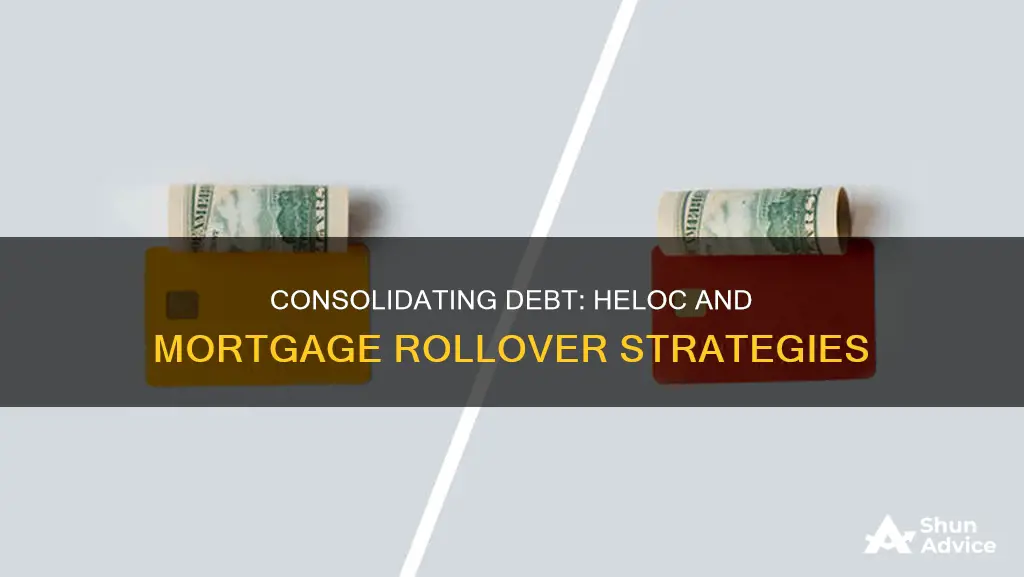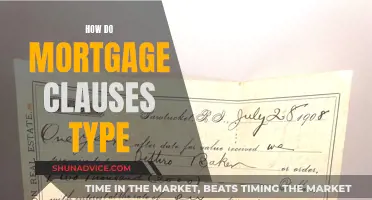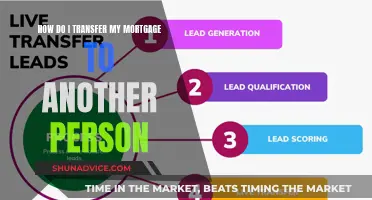
If you're looking to refinance your HELOC into your mortgage, there are a few things to consider. Firstly, refinancing can help you secure a fixed interest rate, making your payments more predictable. It can also lower your monthly payments and give you access to more funds. However, refinancing comes with significant closing costs and other fees, which may outweigh the benefits if the reduction in interest rate is not substantial. It's important to evaluate your financial situation and consider the benefits and drawbacks of refinancing before making a decision.
| Characteristics | Values |
|---|---|
| Main Advantage | Consolidating payments into one monthly bill |
| Interest Rate | Reduced interest rate compared to HELOC |
| Closing Costs | 2% to 5% of the loan's value |
| Refinancing Time | Several weeks to several months |
| Refinancing Requirements | Meet lender's income and home equity requirements |
| Refinancing Documents | Wide variety of documents for the lender to review your financial situation |
| Refinancing Alternatives | Home equity loan |
| Refinancing Drawbacks | Delay in paying off the loan, resulting in higher interest costs in the long run |
| Refinancing Options | Lengthening the repayment term, rolling the balance into a new HELOC, or a cash-out refinance |
What You'll Learn

Pros and cons of rolling HELOC into mortgage
Rolling a HELOC into a mortgage can simplify your monthly finances by consolidating multiple payments into a single bill. This can be particularly beneficial if you are facing challenges in paying back your HELOC loan. However, it is important to carefully consider the pros and cons before making a decision.
Pros
Rolling a HELOC into a mortgage can provide the following benefits:
- Simpler finances: Combining your HELOC and mortgage payments into a single bill can make your finances more manageable and predictable, especially if you have a fixed-rate mortgage.
- Reduced interest rates: Mortgages typically have lower interest rates than HELOCs. By rolling your HELOC into your mortgage, you can take advantage of the lower interest rate and save money. This is especially beneficial if mortgage rates have dropped recently.
- Stability: Mortgages usually have stable interest rates, whereas HELOC interest rates can fluctuate. Rolling your HELOC into your mortgage can provide more stability and predictability in your finances.
- Extended repayment period: Refinancing your HELOC into a mortgage will likely extend the repayment period, resulting in lower monthly payments. This can be beneficial if you need to reduce your monthly expenses.
Cons
There are also several potential drawbacks to consider:
- Higher interest costs: While the interest rate may be lower, extending the repayment period can result in paying more interest over the long term.
- Closing costs: Refinancing a HELOC into a mortgage typically incurs closing costs, which can be substantial. These costs may offset any savings you achieve from the lower interest rate.
- Strict requirements: HELOC refinance requirements have become more stringent in recent years. You will need to meet minimum lending guidelines and have sufficient equity in your home to qualify for a refinance.
- Longer repayment period: While extending the repayment period can reduce your monthly payments, it also means you will be paying off the debt for a longer period.
- Risk of higher overall cost: Even with a lower interest rate, stretching out the repayment of a loan balance can increase your overall interest expense.
Obtaining Mortgage Lien Documents: A Step-by-Step Guide
You may want to see also

Cash-out refinance
A cash-out refinance is a type of mortgage refinance that allows you to convert your home equity into cash. It replaces your existing home mortgage with a new, larger loan, and the difference between the new and old mortgage amounts is paid out to you. This can be used for debt consolidation, funding a major project, or other financial needs.
To be approved for a cash-out refinance, you will need to meet certain requirements, including income and home equity qualifications. Generally, you should have at least 20% equity in your home, although the maximum loan amount can be up to 80%-90% of your home's value. Lenders will also consider your debt-to-income ratio (DTI), which is your monthly debt payments divided by your gross monthly income. Typically, you will need a DTI of 45% or less, and a credit score of at least 620.
The process of refinancing your home can take several weeks to several months, and you will need to gather various documents for the lender to review your financial situation. There are also closing costs associated with a cash-out refinance, which can range from 2% to 6% of the loan amount. These costs should be considered when deciding whether to refinance, as they may offset the savings from the lower interest rate.
A cash-out refinance can be a good option if you are looking to pay off a HELOC, as it can consolidate your payments into one monthly bill with a stable interest rate. It is important to weigh the pros and cons before committing to a cash-out refinance, as you will be repaying a larger loan with different terms and a new mortgage rate.
One alternative to a cash-out refinance is to convert your HELOC into a fixed-rate loan. This can be done by refinancing with a new lender or working with your current lender to switch to a fixed-rate option. However, it is important to consider the costs and benefits of each option, as there may be closing costs and other fees associated with refinancing.
Solo Mortgage Applications: A Comprehensive Guide
You may want to see also

Fixed-rate loan vs. variable-rate loan
If you're considering rolling your HELOC into your mortgage, it's important to understand the differences between a fixed-rate loan and a variable-rate loan. A fixed-rate loan is a loan where the interest rate remains the same for the entire duration of the loan. This means that your monthly payments will not change, regardless of market fluctuations. Fixed-rate loans offer stability and predictability, making it easier to plan and manage your finances. On the other hand, if you opt for a variable-rate loan, the interest rate will fluctuate based on an underlying benchmark or index, such as the federal funds rate. As a result, your monthly payments will vary as well. Variable-rate loans can be advantageous in a declining interest rate market, as your loan payments will decrease. However, when interest rates rise, your loan payments will also increase.
When deciding between a fixed-rate and a variable-rate loan for your mortgage, there are several factors to consider. Firstly, evaluate your financial goals and risk tolerance. Fixed-rate loans are generally preferred if you prioritize consistent monthly payments and long-term predictability. In contrast, variable-rate loans can offer lower initial interest rates and may be more suitable if you're comfortable with some level of uncertainty and potential increases in your monthly payments. Secondly, consider the current and anticipated market conditions. If interest rates are expected to decline, a variable-rate loan could be more beneficial, as you would take advantage of the decreasing interest rates over time. On the other hand, if interest rates are expected to rise, locking in a fixed-rate loan can protect you from these increases.
Additionally, it's important to review the terms and conditions of your existing loans and carefully calculate the potential costs and savings of refinancing. Consolidating your HELOC and mortgage into a single loan can simplify your repayment process and reduce your overall monthly expenses. However, refinancing often comes with closing costs, which can range from 2% to 5% of the loan's value. Therefore, it's crucial to weigh the potential savings against the upfront costs to ensure that refinancing aligns with your financial goals.
Another option to consider is a split rate loan, also known as a hybrid ARM (Adjustable-Rate Mortgage) loan. This type of loan allows you to split your loan amount between fixed and variable interest rates, giving you the benefits of both types of loans while mitigating rate risk. A popular choice is the 5/1 ARM, where the rate remains fixed for the first five years and then adjusts annually. This option can provide stability in the short term while allowing you to take advantage of decreasing interest rates in the future.
Ultimately, the decision between a fixed-rate and a variable-rate loan depends on your unique financial circumstances, risk tolerance, and market expectations. Carefully evaluate your options, seek professional advice if needed, and choose the loan type that aligns best with your short-term and long-term financial goals.
Prepaying Your Mortgage: Strategies for Financial Freedom
You may want to see also

Consolidating payments
However, it is important to note that refinancing your HELOC into your mortgage will result in closing costs, which can be significant. These costs may include title search fees, origination fees, appraisal fees, and other fees charged by your lender. Closing costs typically range from 2% to 5% of the loan's value, but they can sometimes be rolled into your new mortgage. It is essential to consider whether the benefits of refinancing outweigh these costs.
Another factor to consider is the interest rate on your HELOC and mortgage. If you have a small-to-moderate HELOC balance and a low-interest rate on your mortgage, refinancing may not be the best option. In some cases, you may be able to find alternative ways to pay off your HELOC without refinancing. Additionally, if you are about to enter the repayment period of your HELOC, it may make sense to refinance even if you have a lower interest rate on your HELOC than what you would get with a refinance.
Before making any decisions, it is important to consult with a financial professional to understand the potential impact on your payments and to explore other options for managing your HELOC.
Making Overpayments on Your Barclays Mortgage: A Guide
You may want to see also

Closing costs
Some lenders may also charge additional fees, such as annual charges, minimum withdrawal fees, or inactivity fees for not using the HELOC. Early closure fees may also apply if you close your HELOC account before the end of the agreed-upon term. These fees can range from $200 to $500.
It is important to carefully review the terms and conditions of your loan agreement to understand all the fees and charges associated with your HELOC and mortgage. It is also a good idea to compare offers from multiple lenders to find the most cost-effective option for your financial situation.
Proving Your Mortgage Payment: Documenting Your Final Payment
You may want to see also
Frequently asked questions
Rolling your HELOC into your mortgage can help you avoid a spike in your monthly payment. It can also reduce your interest rate and consolidate your payments into one monthly bill.
Closing costs are the main downside, which can range from 2% to 5% of the loan's value. There are also significant upfront fees to consider, which may outweigh the benefits if the reduction in interest rate is not substantial.
The best time to roll your HELOC into your mortgage is when you are about to enter the repayment period of your line of credit.
To roll your HELOC into your mortgage, you will need to apply for a cash-out refinance. This will allow you to consolidate your HELOC and mortgage into a new loan with a lower interest rate.







